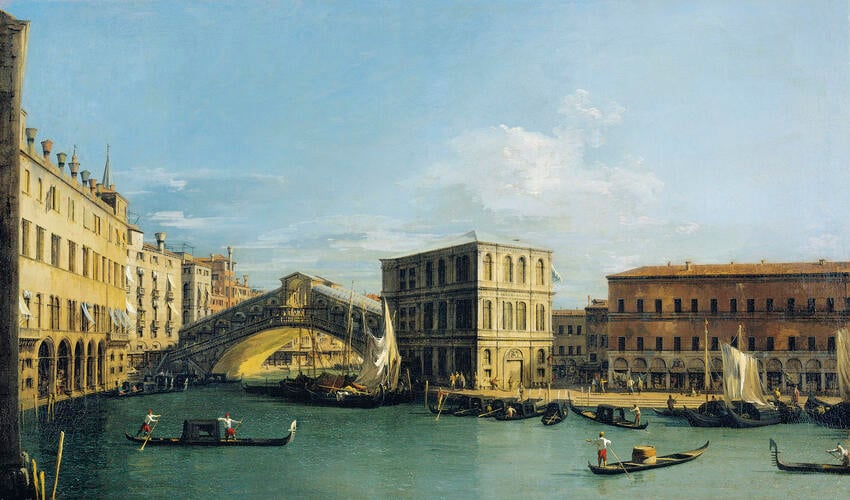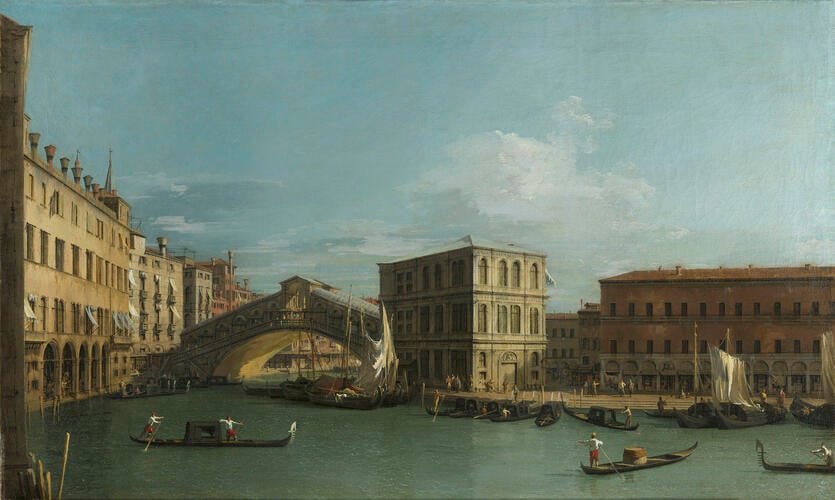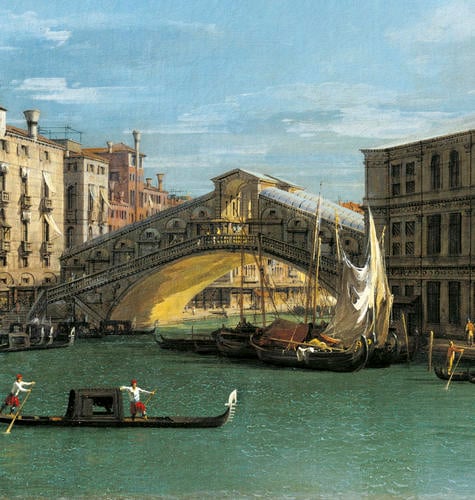-
1 of 253523 objects
The Rialto Bridge from the North c.1726-27
Oil on canvas | 47.5 x 79.9 cm (support, canvas/panel/stretcher external) | RCIN 400668
-
This is one of a series of twelve views by Canaletto of the Grand Canal which are all the same format. The pictures form the basis of the fourteen engraved plates in Visentini's 'Prospectus Magni Canalis Venetiarum' (Venice, 1735), thus providing an uncontested date for completion. It is thought that they originated in the years around 1730. The paintings were all acquired by George III with the collection of Consul Smith.
The painting records the view from roughly the same point (or range of points) as The Grand Canal looking north-west from near the Rialto, but looks in the opposite direction to take in an assemblage of sixteenth-century buildings. The Rialto, at the centre of the natural archipelago, was one of the first areas of Venice to be settled, and has always been the commercial centre of the city. The bridge there, first constructed in wood possibly in the twelfth century, was the only crossing of the Grand Canal until the Accademia and Scalzi bridges were built in the 1850s. The present bridge was built around 1590, an impressive stone structure with a single span of 28 metres (92 feet) incorporating two rows of workshops.
The corner of what is probably Palazzo Civran runs down the left edge of the painting. The early sixteenth-century Fondaco dei Tedeschi, the offices and warehouse of the German traders (now the city post office), is seen obliquely, with the belltower spire of San Bartolomeo just poking above the roof-line. The presence of the Fondaco dei Tedeschi at the heart of Venice's commercial district emphasises the importance of the German trading community in the city. To the right of the bridge is the Palazzo dei Camerlenghi, the seat of the financial officers of the Republic, reconstructed in the 1520s in a restrained Renaissance style on an old five-sided plan that Canaletto has disguised here. Further right are the Fabbriche Vecchie, the block of offices and workshops also built in the 1520s; Canaletto misrepresented their proportions, for the ground-floor arcade should occupy half the height of the building.
There is no one viewpoint that encompasses all these crowded buildings, and Canaletto has opened out the topography to give an impression of space. The bridge has been moved to the left to show most of its width; the short, sunlit façade of the Palazzo dei Camerlenghi actually lies almost flush with the front of the Fabbriche, and Canaletto turned the Palazzo through almost 90° to create a square on the bank of the canal. The composition is close to that of one of a pair of canvases painted in 1725, and he executed versions of the composition many times over the next two decades.
Catalogue entry adapted from Canaletto in Venice, London, 2005.
Provenance
Acquired in 1762 by George III from Joseph Smith, British Consul in Venice (Italian List nos 65-76); recorded in the Gallery at Kew in 1805 (no 15-8)
-
Medium and techniques
Oil on canvas
Measurements
47.5 x 79.9 cm (support, canvas/panel/stretcher external)
66.7 x 98.7 x 10.5 cm (frame, external)
Other number(s)
Alternative title(s)
The Rialto. Venice


